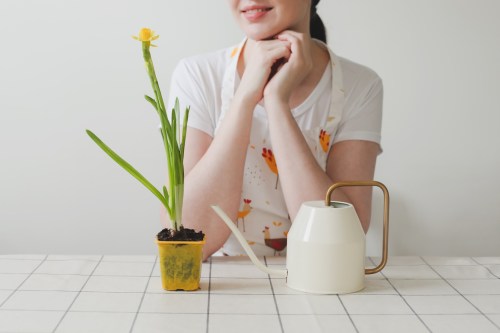Our editors independently select these products. Making a purchase through our links may earn Well+Good a commission
‘I’m a Plant Expert, and Here Are My Top 4 Tips To Make Your Indoor Spring Flowers Last Longer’
Looking for tips to ensure that spring blooms last longer? We've got you covered here, with four from Bloomscape's gardening expert.

Plants and flowers can be effective at relieving stress, boosting one’s mood, and generally being nice to look at. And given that spring has sprung—with colorful blooms dotting gardens everywhere to prove it—maybe you’re looking to spread your plant-parenting wings beyond the scope of, say, the arguably impossible-to-kill snake plant. If you’ve turned your attention to tending to flowering plants, knowing tips for how to extend that timeline for your spring blooms is helpful intel to have. After all, flowers tend to have a shorter lifespan than many houseplants.
Experts in This Article
gardening expert at Bloomscape
So, how can you get around this reality to enjoy those seasonal pops of color for as long as possible? According to Lindsay Pangborn, gardening expert at Bloomscape, it’s possible to exert a bit of control over a number of spring blooms, so long as they’re indoor flowers. That’s because while it’s impossible to control the weather for outdoor flowers (which has implications on their health and longevity), components of an indoor climate is within the realm of management.
While it’s impossible to control the weather for outdoor flowers (which has implications on their health and longevity), indoor climate is within the realm of management.
But, before you go off buying daffodils in bulk, do keep in mind Pangborn’s top piece of general advice: “Buy the plant with the most buds and the fewest open blooms,” she says. “This means you’ll get to enjoy a longer flowering period, since you’ll be able to enjoy the blooms from the moment the flowers begin to open.”
Keep reading to learn four additional tips for making sure that, upon purchase, your indoor flowers’ spring blooms are intact for as long as possible.
4 tips to make spring blooms on your indoor potted flowers last longer
1. Take your plant home asap
Plants are sensitive to their environment, and they prefer consistency. “Once you’ve purchased your plant, take it straight home,” says Pangborn. “Plants are very sensitive to temperature changes, and even just a few minutes too long in a car that’s too hot or cold can cause significant damage.”
While this is a smart rule to follow with all indoor potted flowers, “there are definitely some plants less finicky than others,” Pangborn adds. “A few examples of hardier flowers include hyacinths, tulips, calla lilies, and kalanchoes.” More sensitive plants include hydrangeas, orchids, and African violets,” she says.
2. Choose a good spot in your home for your new plant
“Choose a spot out of direct sunlight, because that can cause the blooms to degrade faster,” says Pangborn. Additionally, she recommends placing the flowers in the center of the room, since that helps protect them from fluctuations in temperature and humidity (like when you open doors or windows).
3. Pay attention to your thermostat
“The cooler the temperature, the longer the blooms will last,” says Pangborn “The warmer the temperature, the faster the plant will use up its resources to grow and cycle through its blooming period, which equates to flowers aging faster.” She recommends keeping your space at a nice 70°F so that your plant baby has some consistency.
“The warmer the temperature, the faster the plant will use up its resources to grow and cycle through its blooming period, which equates to flowers aging faster.” —Lindsay Pangborn, gardening expert
However, dropping “the temperature to between 65°F and 68°F overnight can actually help prolong blooms quite a bit,” Pangborn adds. “This is true for most types of common potted flowering plants. Having slightly cooler nights allows the plant to cycle between active growth and rest, which closely mimics what they experience in their natural environment—and allows flowers to last longer.”
4. Check regularly if the plant needs water
If you’re a dedicated plant parent, you know that plants have their own watering schedule based on the type of plant, the lighting it’s getting, and the current climate it’s in. In order to have your spring blooms last longer, then, Pangborn says you should feel it out and water when the soil is about half dry. You can measure this by sticking your finger in the pot and sensing how wet the soil is and where it starts getting dry. You could also get a snazzy soil moisture meter, which will tell you the moisture level of your flowers’ soil.
“Letting the soil get too dry or keeping it too wet can cause the plant to drop blooms prematurely,” says Pangborn. Additionally, some potted flowering plants come in a decorative sleeve, which can hold water. “Be sure to dump any excess water that collects in the sleeve,” she adds. After all, you’re working so hard to keep your flowers blooming, and you don’t want to risk root rot.
Wondering how to water your plants without, um, killing them? Check out this video on watering plants:
Oh hi! You look like someone who loves free workouts, discounts for cutting-edge wellness brands, and exclusive Well+Good content. Sign up for Well+, our online community of wellness insiders, and unlock your rewards instantly.









